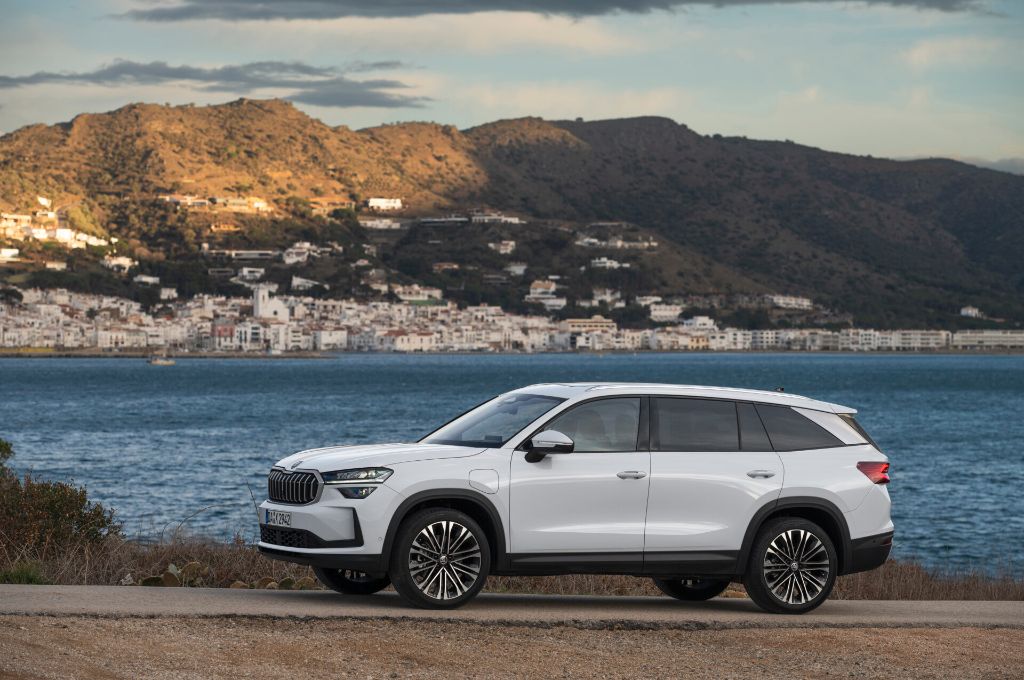Sharing tech and engines with the latest VW Tiguan, the new Skoda Kodiaq arrives in UK showrooms with standard petrol and diesel options, but the plug-in hybrid (PHEV) is likely to hoover up most company car sales and could be a winner for families who can charge at home. It pairs a 1.5-litre petrol engine with a modest electric motor for a 201bhp output and an official electric-only range of 62 miles.
Range, battery & charging
The Skoda Kodiaq PHEV gets a 19.7kWh battery that powers a 113bhp electric motor for double the e-range of Skoda’s previous plug-in hybrid options - none of which were SUVs. While VW offers two specs of Tiguan eHybrid, with 201- or 268bhp peaks, Skoda only offers the former for now. Expect the higher powered version to appear later, perhaps wearing the brand’s popular vRS performance badge and appropriately assertive styling.
The battery will charge at up to 11kW on a home wall box, but it'll also charge at up to 50kW at DC rapid charging stations - which is useful, as not many PHEVs offer rapid charging.
Expect a full top-up to take 2-3 hours at home or around 30 minutes at a rapid charger. Charged up to 100 per cent, Skoda quotes a WLTP range of 62 miles, so factor in the Kodiaq’s fuel tank and you ought to get 550 miles with both petrol- and electric power combined.
Practicality & boot space
Here’s where the Skoda opens up a huge gap over its Volkswagen cousin. This second-generation Kodiaq has grown slightly in length over its predecessor and, with an identical wheelbase, it’s all been channelled into the boot space. With all five seats in place, you get 745-litres of luggage capacity. Flip the back seats down and its 1,945 litres will trump most estate cars.
The only disappointment is that the PHEV’s battery location has stopped Skoda from squeezing in the third row of seats, meaning that the Kodiaq PHEV doesn't get the seven-seat layout of conventional petrol and diesel Kodiaqs. Still, there's tons of headroom for rear passengers, and rear legroom remains almost comically generous. Plus, the rear seats slide fore and aft in a 60/40 split to further boost practicality. So, while we'd love to see the Kodiaq PHEV joining the likes of the Volvo XC90, Mercedes EQB and forthcoming Peugeot e-5008 for electrified seven-seater status, there's no doubting that this is one of the roomiest and most versatile five-seat plug-in hybrid SUVs.
Another Skoda speciality is a host of common-sense touches across the car. As well as its usual trick of tucking an ice scraper in the fuel filler cap and an umbrella in the door, the new Kodiaq adds ventilated wireless phone charging pads (so that your phone doesn't overheat while it's charging) and a bunch of new cubbyholes. Manual gearboxes are no longer available and Skoda has seized the opportunity to move the DSG automatic gearbox's controls up to a stalk on the steering column - freeing up even more storage in the centre console.
While the petrol and diesel Kodiaq 4x4s offer up to 2300kg of towing capacity, the front-driven PHEV claims 1800kg.
Interior & technology
Skoda has gone big on sustainable materials, and many of the Kodiaq’s fabrics are made from recycled plastic bottles. Opt for leather trim, and its tanning process has been done via coffee-bean waste instead of nasty chemicals. If it all sounds a bit too noble, then worry not; these materials look and feel cool and lift the cabin ambience above the slightly dark, plasticky nature of older Skodas (and indeed other VW group products).
A 13-inch central touchscreen, 10-inch digital instruments and tri-zone climate control are all standard, as are heated front seats and keyless start (if not keyless entry, oddly). While the Tiguan offers a larger screen on its options list, you don’t need anything bigger than this.
Crucially, Skoda’s not flung pragmatism – and traditional heater controls – out of the window. Ahead of where you’d previously find a gear lever is a row of three ‘smart dials’, which is a fancy name for rotary controls that have a cute central screen, which make it really straightforward and easy to adjust the air-con temperature and fan speed, heated and vented seats, audio volume, map zoom and drive modes (if you’ve specced posher adaptive DCC+ suspension). It’s another area where the Kodiaq distances itself - for the better - from the Tiguan.
Driving & performance
This new 2024 Skoda Kodiaq has a 10% slipperier aero profile than before (a drag coefficient of 0.28 vs 0.32) but this hasn’t been used to carve out blockbuster acceleration times, but rather improve refinement inside. And it’s worked – this is a serene and placid place during a motorway cruise, and is ideal for peaceful family transport.
The petrol and e-motor feel very neatly integrated, and the handover between them is broadly very smooth. The engine makes a din under heavier acceleration, but it’s simply a clue that you’re driving uncouthly. Smoother inputs (and use of the Eco and Comfort modes, if you’ve specced DCC+) keep the petrol unit schtum for longer, and with prudent use of the throttle you can get comfortably up to motorway speeds on electric power alone, and with very little whine from the electric motor. Deploy both power units to their fullest and you’ll hit 0-62mph in a modestly brisk 8.4secs.
In pure electric mode, the Kodiaq potters around town nicely. There are three levels of brake regen', which are adjusted through the touchscreen, albeit via a handy shortcut to avoid too much fiddling in the move. It’s best left in High, when it assertively slows the car almost to a halt, while Low or Auto modes are less convincing and predictable. It would be nice to be able to adjust this on the move via those new central smart dials, but perhaps a future software update can rectify that.
As well as being more practical, the Kodiaq rides a lot better than its Tiguan relation, too. The adaptive suspension - known as the DCC+ chassis control in Skoda speak - lies on the options list, and is expected to find its way onto around a third of Kodiaqs that are sold in the UK. It brings 15-stage adaptive damping as well as a mixture of different drive modes for steering weight and engine response. In truth, the car steers sharply and rides comfortably enough without it, but keener drives might enjoy that extra layer of customisation.
Running costs & pricing
UK sales initially launch with petrols and diesels, and Skoda hasn’t yet announced official CO2 and fuel economy figures for the PHEV, nor pricing, though we’d expect it to start at around £40,000. The 1.5-litre mild hybrid, which uses a tiny sliver of electrification to smooth out the stop/start procedure and to hush the engine during motorway cruising, starts at £36,645.
Base SE spec brings the big touchscreen and digital dials, heated front seats, 18-inch alloys, and front and rear LEDs lights, plus a bunch of active safety systems including Front Assist (which brakes for vehicles, pedestrians or cyclists), Blind Spot Detection (with door exit warning) and Front Cross Traffic Assist.
A £3,560 upgrade to SE L spec yields larger wheels, keyless entry, LED Matrix headlights, leather seats inside plus electrical adjustment for the driver’s seat and remote electric boot opening. The next rung up is Sportline trim for exclusive 19-inch (and optional 20-inch) wheels and lots of black detailing – including those spangly new rear pillars, which are usually silver – to help it ape performance vRS models. But a bona fide vRS will also join the range at the end of 2024, likely priced close to £50,000.
Verdict
The second coming of the Skoda Kodiaq looks a lot chintzier than before, but its fussy styling hides an otherwise evolutionary step for one of the very best sensible cars on sale. Seven-seaters are surprisingly rare since the MPV market shrunk, and few balance costs and quality like a Kodiaq. The PHEV is a welcome addition to the range, though it’s a shame it’s limited to five seats. For private buyers – especially those without home charging – the pair of diesels on offer might bring similar comfort and economy while offering that optional third row of seats.
We ought to reserve a full verdict on the PHEV for when prices and official economy figures arrive, too. But if the sums work and you can make the most of its strong e-range, here’s a cavernous and comfortable five-seat SUV that’s convincingly made the jump to electrification.
Like the Skoda Kodiaq PHEV? Try these...
























